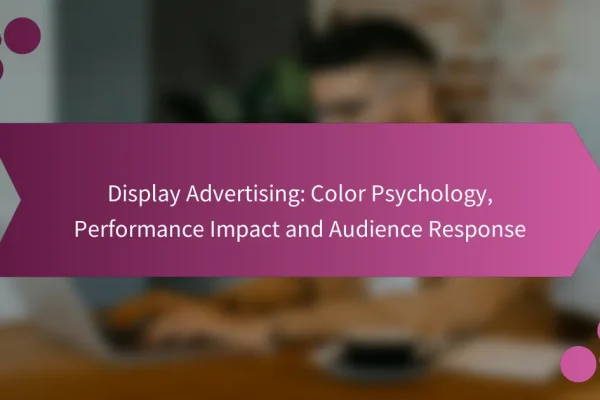How to optimize ad creatives for display advertising?
To optimize ad creatives for display advertising, focus on testing, personalization, and data-driven design. These strategies enhance engagement and conversion rates by tailoring ads to audience preferences and behaviors.
Utilize A/B testing for creatives
A/B testing involves comparing two versions of an ad to determine which performs better. By changing one element at a time, such as the headline, image, or call-to-action, you can identify what resonates most with your audience.
Start with a small sample size and run tests for a few days to gather meaningful data. Aim for a statistically significant result before making changes to your broader campaign.
Incorporate dynamic content personalization
Dynamic content personalization tailors ads to individual user preferences based on data such as browsing history or demographics. This approach can significantly improve engagement by making ads more relevant.
For example, if a user frequently searches for outdoor gear, displaying ads featuring hiking equipment can increase the likelihood of conversion. Utilize tools that allow for real-time content adjustments based on user behavior.
Leverage eye-tracking studies for design
Eye-tracking studies help identify which elements of an ad capture attention and drive engagement. By analyzing where users look first and how long they focus on specific areas, you can optimize your ad layout.
Consider using bold visuals and clear calls-to-action in the areas where users tend to focus most. This can enhance the effectiveness of your creatives and improve overall performance.
Apply data-driven design principles
Data-driven design principles involve using analytics to inform your creative decisions. Analyze metrics such as click-through rates and conversion rates to understand what designs work best.
Incorporate feedback loops where you continually refine your creatives based on performance data. This iterative process helps ensure that your ads remain effective and aligned with audience preferences.
What are the best practices for ad creative design?
The best practices for ad creative design focus on clarity, quality, and adaptability. Implementing these strategies can significantly enhance engagement and conversion rates.
Focus on clear messaging and branding
Clear messaging and strong branding are essential for effective ad creatives. Your message should be concise and immediately convey the value proposition to the audience. Aim for a headline that captures attention and a subheadline that provides additional context.
Incorporate your brand elements consistently, including logos and color schemes, to reinforce brand recognition. Avoid cluttered designs that distract from the main message, as simplicity often leads to better comprehension.
Use high-quality visuals and graphics
High-quality visuals and graphics are crucial for capturing attention and conveying professionalism. Use images that are relevant to your product or service and ensure they are high resolution to avoid pixelation.
Consider using infographics or videos, as they can effectively communicate complex information in an engaging manner. Always ensure that visuals align with your brand identity and resonate with your target audience.
Ensure mobile responsiveness
With a significant portion of web traffic coming from mobile devices, ensuring mobile responsiveness is vital for ad creatives. Your ads should automatically adjust to different screen sizes without losing quality or functionality.
Test your ads on various devices to confirm that text is readable and images are displayed correctly. Prioritize fast loading times, as delays can lead to high bounce rates and lost opportunities.
What metrics should be tracked for ad creative performance?
To effectively measure ad creative performance, focus on metrics such as click-through rates (CTR), conversion rates, and engagement metrics. These indicators provide insights into how well your ads are resonating with the target audience and driving desired actions.
Monitor click-through rates (CTR)
Click-through rates (CTR) indicate the percentage of users who click on your ad after seeing it. A higher CTR suggests that your ad creative is compelling and relevant to your audience. Aim for a CTR of at least 1-2% for display ads, but this can vary by industry.
To improve CTR, consider A/B testing different ad designs, headlines, and calls to action. Ensure that your ads are visually appealing and aligned with the interests of your target demographic.
Analyze conversion rates
Conversion rates measure the percentage of users who take a desired action after clicking on your ad, such as making a purchase or signing up for a newsletter. A strong conversion rate typically ranges from 2-5%, depending on the industry and the offer.
To boost conversion rates, ensure that your landing pages are optimized for user experience and relevant to the ad content. Use clear calls to action and minimize distractions to guide users toward completing the desired action.
Evaluate engagement metrics
Engagement metrics, such as time spent on site, bounce rate, and social shares, provide insights into how users interact with your ad and subsequent content. High engagement often correlates with effective ad creative that resonates with your audience.
To enhance engagement, create ads that tell a story or evoke emotions. Use interactive elements, such as polls or videos, to encourage users to interact with your content and stay longer on your site.
What tools can assist in ad creative optimization?
Several tools can significantly enhance ad creative optimization by providing insights, design capabilities, and editing features. Utilizing the right combination of these tools can lead to improved performance and more engaging advertisements.
Utilize Google Ads for performance tracking
Google Ads offers robust performance tracking features that allow advertisers to measure the effectiveness of their ad creatives. By analyzing metrics such as click-through rates (CTR) and conversion rates, you can identify which ads resonate with your audience.
Set up A/B testing within Google Ads to compare different creatives side by side. This method helps determine which design or messaging drives better results, enabling data-driven decisions for future campaigns.
Employ Canva for design creation
Canva is an accessible design tool that simplifies the creation of visually appealing ad creatives. With a wide range of templates and design elements, users can quickly produce professional-quality graphics without extensive design skills.
Consider using Canva’s collaboration features to gather feedback from team members or stakeholders. This can streamline the design process and ensure that the final product aligns with your brand’s vision and goals.
Use Adobe Creative Cloud for advanced editing
Adobe Creative Cloud provides advanced editing capabilities for those looking to create highly polished ad creatives. Tools like Photoshop and Illustrator allow for intricate design work, enabling you to customize every detail of your advertisements.
When using Adobe, take advantage of its extensive library of resources and tutorials to enhance your skills. This investment in learning can lead to more innovative and effective ad creatives that stand out in a competitive market.
What are common pitfalls in ad creative optimization?
Common pitfalls in ad creative optimization include failing to effectively segment the audience and overcomplicating the message. Addressing these issues can significantly enhance the performance of display ads.
Neglecting audience segmentation
Neglecting audience segmentation can lead to generic ads that fail to resonate with specific groups. Without understanding the different characteristics and preferences of your audience, your messaging may miss the mark.
To optimize ad creatives, invest time in defining segments based on demographics, interests, and behaviors. For example, targeting young adults with trendy visuals may be more effective than using the same approach for older audiences who prefer classic styles.
Overcomplicating the message
Overcomplicating the message can confuse viewers and dilute the impact of your ad. A clear and concise message is essential for capturing attention and conveying the intended call to action.
Focus on a single, strong message that aligns with your brand identity. Use straightforward language and avoid jargon. For instance, instead of saying “utilize our innovative solutions,” simply say “try our new tools today.” This clarity can improve engagement and conversion rates.










